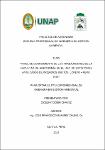Nivel de conocimiento de los trabajadores de la facultad de agronomía en el uso de extintores ante casos de incendios. Iquitos. Loreto - Perú. 2021
Abstract
This research aims to determine the knowledge level in the usage of fire extinguishers in the Faculty of Agronomy workers in the National University of the Peruvian Amazon in 2021. The research, by its approach, was quantitative, forward-looking strategy, with a general descriptive level and non-experimental research design. The target population was fifteen administrative workers (15), the same ones who were the sample of this research. All of them were at the time of implementation of the data-gathering instrument taking into account the inclusion and exclusion criteria. The technique used was the survey, and the tool applied was the ten-item questionnaire, which passed the validity (Aiken's validity index) and reliability (test of two halves) tests. The collected data was analyzed considering the research objectives and hypothesis, then expressed in a Basic Data Matrix (BDM) and analyzed, processed, and tabulated through the statistical package Statistical Product and Service Solutions (SPSS) version 25. The main results showed that 60% of the workers consider that the first thing to do is be qualified to use a fire extinguisher. However, 40% of them believe that it is not required. 80% of the workers did not answer correctly, also that it is false or they do not know whether class B or class C fire is extinct with water. Only 46.7% of the workers answered correctly regarding the first action to take when they see fire, compared to the 53.3% who did not. In the knowledge level about identification, control, and extinction of fire in the workplace, and their expertise handling fire extinguishers, the low level of knowledge prevails with 80%. Thus, rejecting the research hypothesis. La presente investigación tuvo como objetivo general determinar el nivel de conocimiento de los trabajadores de la facultad de agronomía en el uso de extintores ante casos de incendio en Iquitos Loreto en el año 2021. La investigación fue cuantitativa, de estrategia prospectiva, de nivel descriptivo simple y de diseño de investigación no experimental. La población estuvo constituida por quince trabajadores administrativos (15) de la Facultad de Agronomía de la universidad Nacional de la Amazonia Peruana. La muestra lo constituyeron el 100% de la población en estudio, la técnica que se utilizó fue la encuesta y el Instrumento aplicado fue el cuestionario. Los datos obtenidos fueron expresados en una Matriz Básica De Datos (MBD) y analizada, procesada y tabulada a través del paquete estadístico Statical Product and Service Solutions (SPSS) versión 25. Los principales resultados expresaron que el 60% de los trabajadores considera que lo primero que se tiene que hacer es estar entrenado y capacitado para poder usar un extintor de fuego y el 40% de los mismos considera que no es necesario estar entrenado. Así mismo el 80% de los trabajadores no contestaron de manera adecuada o que es falso o no sabe, en cuanto a si a los incendios clase B o clase C se les apaga con agua. Solo el 46.7% de los trabajadores respondieron adecuadamente en cuanto a la primera acción que deben tomar cuando notan la aparición de un incendio, en contraposición el 53.3% de los mismos que no contestaron adecuadamente. En nivel de conocimiento sobre identificación, control y extinción de incendios en el centro laboral, así como su pericia en el uso de los extintores en base las características de los mismos para cada tipo de incendio, predomina el nivel de conocimiento bajo con 80% en dichos trabajadores, rechazándose por lo tanto la hipótesis de investigación.
Collections
- Tesis [501]


